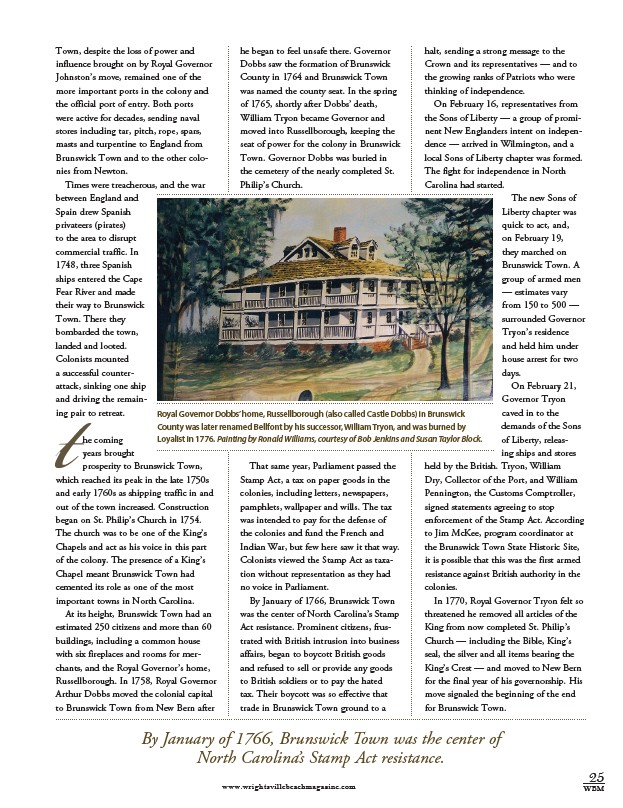
25
Royal Governor Dobbs’ home, Russellborough (also called Castle Dobbs) in Brunswick
County was later renamed Bellfont by his successor, William Tryon, and was burned by
Loyalist in 1776. Painting by Ronald Williams, courtesy of Bob Jenkins and Susan Taylor Block.
www.wrightsvillebeachmagazine.com WBM
Town, despite the loss of power and
influence brought on by Royal Governor
Johnston’s move, remained one of the
more important ports in the colony and
the official port of entry. Both ports
were active for decades, sending naval
stores including tar, pitch, rope, spars,
masts and turpentine to England from
Brunswick Town and to the other colo-nies
from Newton.
Times were treacherous, and the war
between England and
Spain drew Spanish
privateers (pirates)
to the area to disrupt
commercial traffic. In
1748, three Spanish
ships entered the Cape
Fear River and made
their way to Brunswick
Town. There they
bombarded the town,
landed and looted.
Colonists mounted
a successful counter-attack,
pair to retreat. the coming
sinking one ship
and driving the remain-ing
years brought
prosperity to Brunswick Town,
which reached its peak in the late 1750s
and early 1760s as shipping traffic in and
out of the town increased. Construction
began on St. Philip’s Church in 1754.
The church was to be one of the King’s
Chapels and act as his voice in this part
of the colony. The presence of a King’s
Chapel meant Brunswick Town had
cemented its role as one of the most
important towns in North Carolina.
At its height, Brunswick Town had an
estimated 250 citizens and more than 60
buildings, including a common house
with six fireplaces and rooms for mer-chants,
and the Royal Governor’s home,
Russellborough. In 1758, Royal Governor
Arthur Dobbs moved the colonial capital
to Brunswick Town from New Bern after
he began to feel unsafe there. Governor
Dobbs saw the formation of Brunswick
County in 1764 and Brunswick Town
was named the county seat. In the spring
of 1765, shortly after Dobbs’ death,
William Tryon became Governor and
moved into Russellborough, keeping the
seat of power for the colony in Brunswick
Town. Governor Dobbs was buried in
the cemetery of the nearly completed St.
Philip’s Church.
That same year, Parliament passed the
Stamp Act, a tax on paper goods in the
colonies, including letters, newspapers,
pamphlets, wallpaper and wills. The tax
was intended to pay for the defense of
the colonies and fund the French and
Indian War, but few here saw it that way.
Colonists viewed the Stamp Act as taxa-tion
without representation as they had
no voice in Parliament.
By January of 1766, Brunswick Town
was the center of North Carolina’s Stamp
Act resistance. Prominent citizens, frus-trated
with British intrusion into business
affairs, began to boycott British goods
and refused to sell or provide any goods
to British soldiers or to pay the hated
tax. Their boycott was so effective that
trade in Brunswick Town ground to a
halt, sending a strong message to the
Crown and its representatives — and to
the growing ranks of Patriots who were
thinking of independence.
On February 16, representatives from
the Sons of Liberty — a group of promi-nent
New Englanders intent on indepen-dence
— arrived in Wilmington, and a
local Sons of Liberty chapter was formed.
The fight for independence in North
Carolina had started.
The new Sons of
Liberty chapter was
quick to act, and,
on February 19,
they marched on
Brunswick Town. A
group of armed men
— estimates vary
from 150 to 500 —
surrounded Governor
Tryon’s residence
and held him under
house arrest for two
days.
On February 21,
Governor Tryon
caved in to the
demands of the Sons
of Liberty, releas-ing
ships and stores
held by the British. Tryon, William
Dry, Collector of the Port, and William
Pennington, the Customs Comptroller,
signed statements agreeing to stop
enforcement of the Stamp Act. According
to Jim McKee, program coordinator at
the Brunswick Town State Historic Site,
it is possible that this was the first armed
resistance against British authority in the
colonies.
In 1770, Royal Governor Tryon felt so
threatened he removed all articles of the
King from now completed St. Philip’s
Church — including the Bible, King’s
seal, the silver and all items bearing the
King’s Crest — and moved to New Bern
for the final year of his governorship. His
move signaled the beginning of the end
for Brunswick Town.
By January of 1766, Brunswick Town was the center of
North Carolina’s Stamp Act resistance.